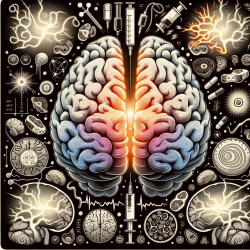The intricate relationship between brain structures and their functions has long fascinated neuroscientists and clinicians alike. A recent case report titled "A case report of a Wada test after dominant hemisphere multiple hippocampal transections: Pathophysiology of confusion after amobarbital injection" provides valuable insights into the pathophysiology of confusion following amobarbital injection during the Wada test. This study is particularly relevant for practitioners involved in epilepsy treatment and those interested in neuropsychological assessments.
The Wada Test: A Brief Overview
The Wada test, or intracarotid amobarbital procedure (IAP), was developed to assess language and memory lateralization before surgical interventions in patients with epilepsy. By injecting amobarbital into one hemisphere at a time, clinicians can observe the effects on language and memory functions. This procedure is crucial for planning surgeries like temporal lobectomies and multiple hippocampal transections (MHTs) to minimize cognitive deficits post-surgery.
Case Study Highlights
The case study involves a 45-year-old male with left mesial temporal lobe epilepsy who underwent MHT. Pre-surgical IAP showed no significant alteration in consciousness when either hemisphere was injected with amobarbital. However, post-MHT IAP revealed marked impairment of consciousness and memory when the intact right hemisphere was injected.
- Pre-MHT Observations: No alteration in consciousness during IAP.
- Post-MHT Observations: Significant confusion and memory loss during right hemisphere injection.
The findings suggest that confusion induced by IAP is due to bilateral hippocampal inactivation rather than selective inactivation of one hemisphere. This has significant implications for understanding the symptomatogenic zones responsible for dialeptic seizures, characterized by altered consciousness without motor manifestations.
Implications for Practitioners
This case report underscores the importance of considering bilateral hippocampal function when evaluating patients for epilepsy surgery. Practitioners should be aware that:
- Bilateral inactivation can lead to significant cognitive disruptions.
- MHT may not always preserve verbal memory as previously thought.
- Comprehensive pre- and post-surgical evaluations are essential to tailor treatment plans effectively.
Moreover, this study encourages further research into the precise mechanisms underlying dialeptic seizures and their symptomatogenic zones. Understanding these mechanisms can lead to improved therapeutic strategies and better outcomes for patients undergoing epilepsy surgery.
Conclusion
The insights gained from this case study highlight the complex interplay between brain structures and their functional outcomes following surgical interventions. By considering bilateral hippocampal function, practitioners can enhance their approach to epilepsy treatment, ensuring that patients receive the most effective care possible.
To read the original research paper, please follow this link: A case report of a Wada test after dominant hemisphere multiple hippocampal transections: Pathophysiology of confusion after amobarbital injection.










